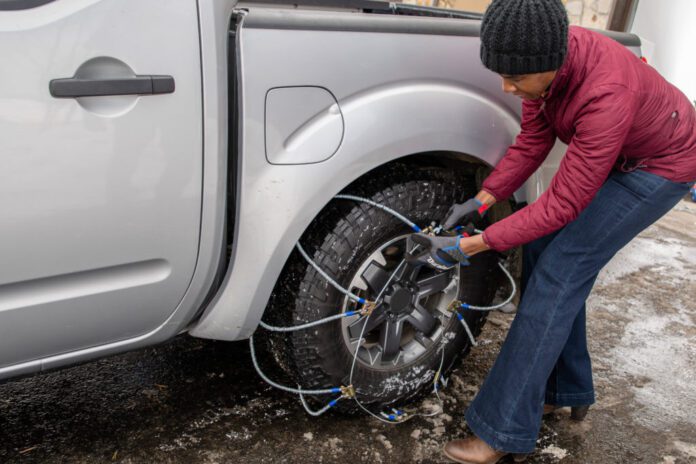There was a time when snow chains were the only way drivers could safely move through snowy or icy roads.
People would carry them in their trunks during the winter months, ready to stop on the side of the road and wrap them around their tires. It wasn’t easy, but it worked—at least back then.
But things are different now. Cars and trucks today are built smarter. They come with tools like traction control systems, anti-lock brakes (ABS), and electronic stability control (ESC)—all of which help your tires stay on the road, even in tough weather.
On top of that, roads are cleared faster, and winters in many places aren’t as harsh as they used to be.
So here’s the big question: Do you still need traditional snow chains? For most drivers, the answer is no.
Today, there are easier, faster, and safer tools available. One of the best examples is TruckClaws™, a modern traction aid that works in snow, ice, mud, and even sand—without the heavy metal chains or the long setup time.
In this post, we’ll explore why traditional tire chains are becoming a thing of the past, and what smarter options drivers now have to stay safe in winter.
Why Traditional Snow Chains Are Losing Relevance
a. Inconvenience in Real Conditions
Snow chains are hard to install, especially in cold weather. You have to stop, kneel, and sometimes use tools. This isn’t safe or easy—especially on busy roads. They can also scratch alloy wheels or damage your vehicle if not fitted right.
b. Limitations in Speed and Terrain
Chains have speed limits (30–50 km/h) and don’t work well on roads that are partly dry. They can break or damage the road. In some places, snow chains are banned, while in others, they’re only allowed during extreme weather.
Because of this, drivers are choosing easier options like snow socks, winter tires, and smart traction aids such as TruckClaws™.
How Modern Vehicles Are Making Chains Obsolete
Today’s cars are built with smart features like traction control, ABS, electronic stability control (ESC), and AWD or FWD systems. These tools help your tires grip the road in snow or ice without needing chains.
Most vehicles now adjust traction on their own. That means drivers rarely need to use manual traction aids like snow chains.
Even electric vehicles (EVs) handle better in winter thanks to fast torque control and built-in traction systems. As a result, chains are no longer a must for many drivers.
Rise of Smarter, Safer, and Easier Alternatives
a. Snow Socks
Snow socks are a modern, lightweight option. They’re simple to slip over tires and take just a few minutes to install. Unlike metal chains, they’re safe for alloy wheels and won’t cause damage.
They work well for short trips and urban winter driving, especially on cars with ABS or ESC. But they wear out quickly in deep snow or rough roads, and they’re not ideal for trucks or heavy vehicles.
b. TruckClaws™ – A Heavy-Duty, Multi-Surface Alternative
For bigger vehicles or tougher jobs, TruckClaws™ offer a strong solution. They give fast traction in snow, mud, ice, and even sand. You can install them without removing the tire, which makes them perfect for emergency use, off-road driving, or commercial trucks.
Unlike snow socks or traction mats, TruckClaws™ are reusable and built to last in harsh conditions. They’re a reliable choice when you need strong grip fast—no tools, no fuss.
Climate & Infrastructure: A New Reality
In many cities today, road conditions are not as harsh as before. Warmer winters, caused by climate change, mean there’s less ice and snow on the roads in many areas.
At the same time, road crews are now quicker and better equipped. They use salt, gravel, and even liquid treatments to keep roads safe. This reduces the need for extra tools like snow chains in most urban areas.
Because of these changes, drivers are depending more on their vehicle’s traction control systems and less on old methods like chains or mats.
Where Chains Still Matter (And Where They Don’t)
Snow chains haven’t disappeared completely. In some mountain regions like California and Colorado, they’re still required by law — especially for commercial trucks during heavy snow.
But not all places follow the same rules.
Many states now allow traction alternatives that meet safety standards. Tools like TruckClaws™, snow socks, and other approved devices are now accepted — as long as they give the same level of grip.
If you’re traveling across states, always check the local traction laws before winter hits.
The Future of Tire Traction: Built-In & On-Demand
The way we deal with snow and ice is changing fast. New cars may soon come with built-in traction systems — no need to attach anything.
Tech like memory alloy tires and smart rubber compounds is already being tested. These materials can adjust grip based on road conditions, offering on-demand traction without any manual setup.
But we’re not there yet.
Right now, tools like TruckClaws™ and snow socks are the best step forward. They’re easier to use than chains, safe for your vehicle, and accepted in many places. TruckClaws™ in particular gives strong grip in deep snow and mud, making it a reliable traction aid for both regular drivers and commercial vehicles.
Conclusion: Smarter Traction Is the Way Forward
Traditional snow chains had their time, but for most drivers today, they’re no longer the best choice. They’re hard to install, tough on your vehicle, and not always legal.
Now, we have better options.
Snow socks are great for everyday drivers who want quick and simple traction. For truckers, off-roaders, and anyone who faces serious snow or mud, TruckClaws™ stands out as a powerful, practical solution.
Winter driving doesn’t have to be a struggle anymore — smarter, faster, and safer traction tools are here to stay.










